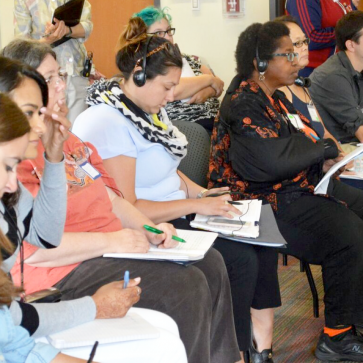This course provides a structured, in-depth look at Teaching Through Problem-Solving, an approach that builds students’ mathematical knowledge, reasoning, and dispositions through problem-solving.

In this module, you will plan and conduct a TTP lesson using your own curriculum materials and a Study, Plan, Teach, Reflect process. Use the Teaching-Learning Plan Template to record your ideas throughout the process. If it is feasible to invite a few colleagues to observe your lesson (Step 4:3) and collect data on focal students, this may provide valuable information about students’ experience of the lesson.
4.1: Study
Investigate Standards & Curriculum
Find a topic within your own curriculum where you would like to try out a TTP lesson. Examine your standards (as well as related frameworks, etc.) and your curriculum. Figure out:
- How does student learning of this topic develop over the grades?
- What challenges and misconceptions are typical?
- How does your curriculum help students develop the key understandings of this topic, and what are the key models and tasks expected to spark student understanding?
Capture what you learn by completing the following sections of the Teaching-Learning Plan:
| Teaching-Learning Plan |
ii. Research on the Contentiii. Relationship of the Topic to the Standards |
Identify the Lesson, Try the Problem and Anticipate Student Thinking
Find a lesson within this topic that you would like to teach as a TTP lesson and identify the key understanding(s) students develop within the lesson. Tweak the lesson task, if needed, to provide a rich task that will enable students to build the new mathematical idea by solving a problem that embodies it. Try the task and anticipate how different students in your class will respond to the task.
- What is the key understanding to be developed in this lesson and how do students develop this understanding?
- (optional) What is the role of this lesson within a larger unit of study around this topic? What are the unit goals and how does each lesson in the unit contribute to them?
Try the task and anticipate how different students in your class will respond to the task. Figure out:
- What is the key understanding to be developed in this lesson and how do students develop this understanding?
Capture what you learn by completing the following sections of the Teaching-Learning Plan:
| Teaching-Learning Plan |
iv. Goals of the Unit (optional)v. Unit Plan (optional)vi. Goals of the TTP Lesson |
4.2: Plan
Now that you have considered the big mathematical ideas to be built during the lesson and anticipated student responses, you can plan the lesson flow that will help students build from their current knowledge to the new mathematical understanding you are aiming for.
As you plan your lesson flow and TTP instructional supports, revisit the relevant sections of Modules 1 and 2. Links are provided below.
4 phases of a TTP lesson
Neriage Discussion
Teacher Questioning
Student Journal Use
Board Organization
Neriage ("Kneading") Discussion
Neriage provides the bridge from students’ current understanding to the new mathematical idea you want them to understand by the end of the lesson. Questions to help you plan the neriage are:
- What knowledge will students bring to the problem?
- What new understanding will they build during the lesson?
- What specific experiences and insights will help students progress from their initial knowledge to the new understanding?
After thinking about these questions, plan the neriage:
- Decide which solution strategies students will present, and in what order
- Identify what students need to notice about each solution approach and about the similarities or differences between them
As you plan the neriage, recall that its purpose is for students to uncover the important mathematical ideas as they analyze and compare solutions. The teacher’s role is to monitor and facilitate discussion toward the lesson’s major learning.
Teacher Questioning
Now that you have planned the flow of the neriage, consider the specific questions you will ask at each phase of the TTP lesson, and note your ideas in the TTP Teaching and Learning Plan (section viii, Lesson Plan). In particular, write down: ?
- The teacher questions and moves that will help students present, unpack, compare, and analyze the solution strategies
Reflective Student Journals
Student journals can also make a powerful contribution to students’ mathematical agency, as we saw in Dr. Takahashi’s lessons. If you are not already using reflective mathematics journals in your classroom, we encourage you to try them as part of your TTP lesson planning.
You can find more advice about using student journals in the course ‘Try Math Journals in your Classroom’ or Take the 30-day math journal challenge!
As part of your TTP work, you might want to identify one or more aspects of journal writing you want students to build, such as:
- Writing mathematical expressions to go with their pictures and explanations
- Recording classmates’ ideas as a resource to deepen their own thinking
- Recording how their thinking changed (by crossing out and adding writing, rather than erasing)
- Writing "What I learned" (and you can present several student reflections to begin the next lesson)
Capture your thinking by completing the following sections of the Teaching-Learning Plan:
| Teaching-Learning Plan |
vii. Rationale for the Design of Instructionviii. TTP Lesson Plan |
Board Organization
Using a blank board plan, you can think through additional aspects of the lesson. For example, what do you hope students will say at the end of the lesson as a summary of what they learned? What do you hope they will notice as they compare and synthesize the student work on the board?
You may also want to identify aspects of board writing that you want to work on, such as:
- Student work that is easily visible to classmates, and uses color, arrows, etc. for visual clarity
- Mathematical expressions to go with each visual or verbal representation
- Writing conventions that help students become metacognitive and organized in their own journal writing–such as particular colors to designate key learnings or to correct mistakes, thought bubbles to show student thinking, etc.
- A consistent organization that shows the whole flow of the lesson, so that students always know where to look for the problem, classmates’ solution methods, what was learned by comparing solution methods, etc.
Capture your learning by completing the following sections of the Teaching-Learning Plan:
| Teaching-Learning Plan |
ix. Draft Board Plan |
4.3: Teach
Now it’s time for the most interesting part of any research effort: seeing how your ideas fare in practice!
It is important to remember that a lesson is a “swiftly flowing river.” However carefully you have anticipated student thinking and designed the lesson, unexpected things may happen, and the teacher’s role is always to exercise professional judgment in the moment about what will best serve the students–not to follow a lesson plan no matter what. The gaps between what we expected and what unfolded can spark powerful insights. The Teaching-Learning Plan was produced through careful study, but should still be regarded as a contingency plan, not a blueprint.
Observers
If observers are joining your TTP lesson, they should know their data collection assignment and be well-prepared to serve as “eyes and ears, not mouths and hands.” Ask observers to read your Teaching-Learning Plan before the lesson and to focus on the specific student(s) and data collection you request. It is most useful if each observer focuses on one student or group from the start to finish of the lesson to understand exactly how learning progressed for the student(s), and what supported or obstructed learning. If possible, observe students who will enable you to understand how the lesson played out for different learners–for example, second language learners versus native speakers, reluctant versus eager learners, struggling and non-struggling students.
4.4: Reflect
What did you learn? If possible, arrange for some time to reflect immediately following the lesson. If not, set aside student work and artifacts from the lesson for careful review later in the day. If you reflect with colleagues who observed your lesson, it’s important to spend some quiet time (at least 10 minutes) to review student work and artifacts from the lesson before talking as a group. Key issues to reflect on include:
- What you noticed about student thinking and how it changed during the lesson
- What student journals and other lesson artifacts tell you about student thinking during the lesson, any changes in student thinking, and what sparked these changes
- Anything that was surprising or unexpected in the lesson
- What elements of the lesson plan worked well to elicit and build student thinking and what did not
Once you have had a chance to consider these ideas during quiet reflection time, share out ideas with colleagues, or create your own summary by drawing on evidence from student work. If working with colleagues, adopt norms that emphasize data-sharing from student work and student discussions rather than evaluative statements. Be as specific as you can drawing on evidence from student work and student discussions.
Capture what you learn by completing the following sections of the Teaching-Learning Plan:
| Teaching-Learning Plan |
x. End of Lesson Reflection |
4.5: Next Steps
What Next? You’ve now completed a TTP lesson thought carefully about the phases of the TTP lesson about the neriage, for one mathematical topic, and about instructional routines to make student thinking visible, such as student journals and board organization. Take some time to consolidate your learning from this course and think about what you want to make your own. For example, did you learn anything that you want to carry back into your practice about:
- The mathematics
- Student thinking
- Teaching through problem-solving elements such as planning the selection and discussion of student work, and using questioning, journals, and board planning to make student thinking visible
- Professional learning habits, such as anticipating student thinking, examining student work, or studying and curriculum materials, standards, and what is known about the teaching-learning of the content
Consider selecting another mathematical topic to explore using a Teaching Through Problem-solving approach. Materials to plan a Teaching Through Problem-solving unit on fractions are available as a self-guided course. Or perhaps you would like to work on a particular element of Teaching Through Problem-solving that you learned about in the course and want to develop in your daily classroom practice.
Whatever your next steps, please don’t hesitate to contact us and share your successes, questions, and challenges. We are eager to hear from you!




